Signs of "Connected Consciousness" Detected on Global Scale
- By Richard Samson - September 28, 2014
 |
Our individual minds, though distinct and uniquely ours, may also join with others in a kind of mental symphony that now and then becomes audible against a prevailing background of static. That's a conclusion suggested by the Global Consciousness Project (GCP), which got its start at Princeton University in 1998 and now operates as an international collaboration. |
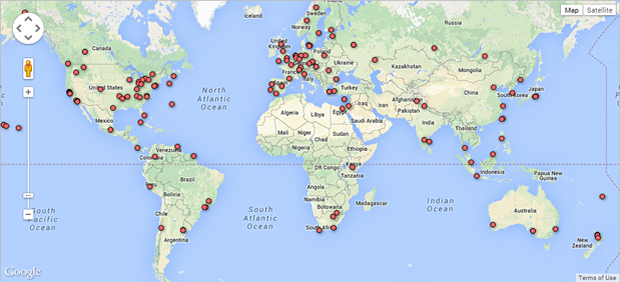
Global Consciousness Project locations
After 16 years of monitoring more than 480 world events, researchers report strong evidence of some kind of transpersonal mentality that seems to emerge when many people share a common concern or experience. At such times, a global network of devices employing quantum tunneling has found weak but definite signs of coherence arising out of background "noise" or randomness.
Although the evidence has been known by specialists for years, it has grown so strong it now warrants public attention. And it comes at a time when the materialistic assumptions of traditional science, particularly physics, are being challenged.
The measured effect, though faint and fickle, is statistically significant to an extremely high degree, according to the researchers. It shows up during times of crisis or celebration, such as an earthquake or New Year's Eve, when millions of people focus on the same thing at the same time.
Although far from final and definitive, the research suggests that our minds may not be bounded by our heads but somehow extend out into the world and commingle, at least at times. "What we can interpret from our experiments is that we really are interconnected," says Roger Nelson, GCP's Director. "Human beings are simply not isolated islands of consciousness."
The Research in a Nutshell
The detection system is a global network of random number generators (RNGs) based on quantum tunneling. Up to 70 are active at any one time. Each RNG outputs a continuous stream of completely unpredictable zeroes and ones. The stream ordinarily averages out at 50% ones and 50% zeros, just as flipping coins tends to produce roughly equal heads and tails over time. The RNG data are transmitted to a central archive for later analysis.
When events engage millions of minds and hearts at once, structure seems to emerge out of what would otherwise be randomness. The global network departs a bit from the normal generation of random ones and zeros. The RNGs' behaviors become slightly correlated and the system as a whole appears to shift toward coherence.
It doesn't happen every time, but often enough and strongly enough to produce compelling statistics. The chart below shows the combined output of the RNG network before, during and after 9/11/2001, the day the Pentagon and World Trade Center were attacked. The odds that the apparent structure in the project database for that day is due to chance are about one in 32, considered statistically significant. When this event's data are combined with that of other events studied on other days, the odds against chance rise exponentially.
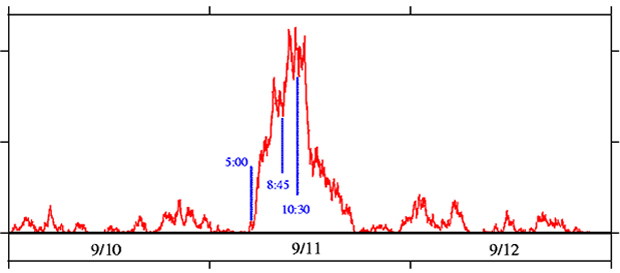
Output of Global Consciousness Project computers on 9/11/2001
Image source: Global Consciousness Project
Many types of events have been studied: natural disasters, religious holidays, airline crashes, military invasions, acts of terror, peace vigils, and political events such as Obama winning the presidency in 2008. The chart below summarizes the aggregate results of all studies.
The jagged red line shows the accumulating excess of empirically developed scores relative to expectation for the complete dataset of defined events. The odds against chance are more than a trillion to one, after more than 480 studies. As additional events have been studied, the degree of significance has steadily increased.
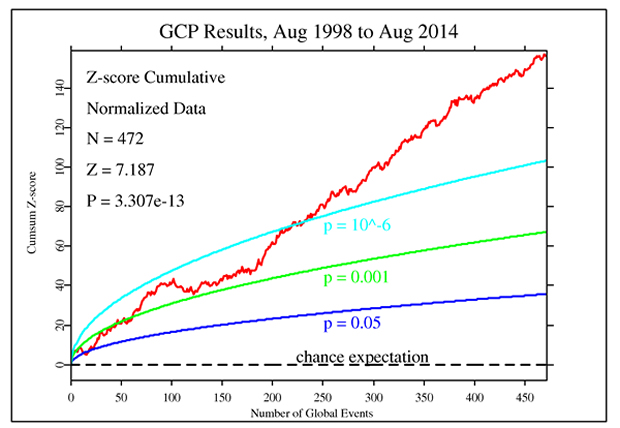
Aggregate results of Global Consciousness Project studies through August 2014
Image source: Global Consciousness Project
All efforts to invalidate the data or the conclusions have so far failed. For example, the team compared earthquakes that occurred under the ocean to those occurring on land. The prediction was that only the land-based quakes would produce a significant effect, since quakes at sea have hardly any impact on people. The RNG readings validated this prediction.
No one knows exactly why and how such deviations from chance happen. But they do. For a more detailed description, see the Deeper Explanation section, below. For complete information, see the Global Consciousness Project.
The Bottom Line?
"We can conclude," says Nelson, "that there really are effects of consciousness in the world, unexpected correlations in our network of random devices. Something is going on, and the most likely conclusion is that there is an interconnection of consciousness at deeply hidden levels between people and among people across the globe."
Why Is It News Now?
Results of the GCP studies have been published on many occasions over the past 16 years, but never widely noted by the general media. Now may be the time to start paying attention.
Why? For one thing, the statistical certainty has mounted to the point that it's hard to ignore. Toward the end of 1998, the odds against chance started exceeding one in 20, an acceptable level in many disciplines. Then, with added studies, the level of certainty began to zoom. By the year 2000, the odds against chance exceeded one in 1,000; and in 2006, they broke through the one in a million level; they're now more than one in a trillion with no upper limit in sight.
This far exceeds the bar for statistical significance used in many fields, such as medicine and weather forecasting. Odds against chance ranging from 20-to-one to 100-to-one are commonly considered sufficient. The certainty level is set unusually high for the Higgs Boson; data for validating its existence are considered acceptable if they exceed one in 3.5 million. The GCP level of statistical certainty is now more than 285,000 times greater than that.
In addition to the mounting weight of the evidence, there's another reason it may be newsworthy now. It could help alter a mindset that perpetuates our problems. As Nelson puts it, "The more we understand we're all 'one,' as the sages of all cultures put it, the better able we'll be to shift our activities to realize our huge, wonderful potential." Without a course change, he adds, "we may not have a future at all."
Long-term Significance
Small indications often portend big developments. Tenuous evidence of connected consciousness might be the sprouting seed of something. What?
An early student of global awareness was Pierre Teilhard de Chardin, 1881-1955, the French philosopher, Jesuit priest, paleontologist and geologist. Teilhard refined Vladimir Vernadsky's concept of noosphere (the ultimate sphere of consciousness) and conceived the idea of the Omega Point. That's the level of maximum complexity, coherence and consciousness that would be the end point of evolution, he said. Aided by technology and prompted by population growth, the earth as a whole would eventually become conscious, embracing and enriching each individual's awareness, Teilhard argued.
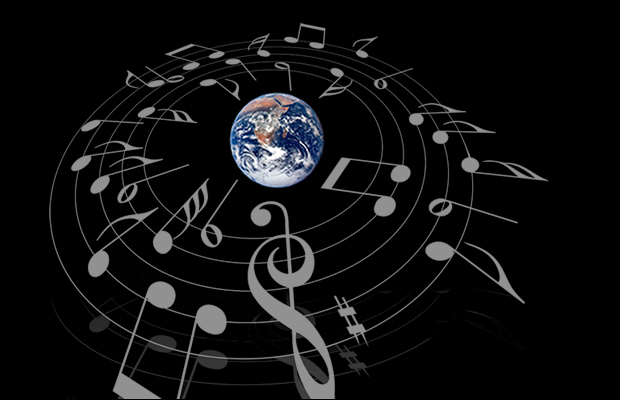
Is a "mental symphony" tuning up?
Image sources: musical notes, ClipArt Best; earth, NASA
Nelson speculates that we may be witnessing the first flickers of such an eventuality. "What we see in the global consciousness correlations may be some very faint version of Teilhard's noosphere," he says. It may take 10,000 years to materialize, he cautions. But we might enjoy the flickers along the way.
Social Implications Today
Solid evidence that consciousness is global and mutual could have a salutary effect by prompting reconsideration of the assumption dominating our era: that matter rules. But what if mind rules? That's the big question implied by the research; and a widespread consideration of it could prove liberating.
Toward that end and with the noosphere vision in mind, now may be the time, Nelson suggests, for a shift from biological evolution to conscious evolution – the intentional enhancement of individual, group, and global consciousness. "To make a real difference," he says, "what we'd need are perhaps 100 million people, out of the seven billion on the planet, all becoming deeply persuaded and able to work on a kind of conscious evolution strategy."
A realistic optimist, Nelson also offers a more modest proposal. "What we can all do," he says, "is learn to live in the world in a positive, accepting fashion, in which case the world will roll out toward its future, taking us along on a probably more pleasant ride."
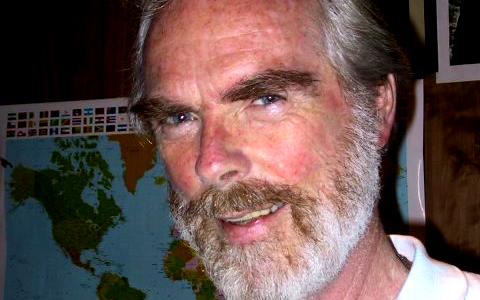
Roger Nelson, GCP Director
Image source: Global Consciousness Project
Research Background
Controlled laboratory research on interactions of consciousness with physical random systems began in the 1960's. Helmut Schmidt at Boeing Laboratories conducted the first large database experiments, followed by other researchers through the 60's and 70's.
In 1979, Robert Jahn established the Princeton Engineering Anomalies Research (PEAR) laboratory at Princeton University. A key aim was to study whether sensitive electronic devices might be affected by special states of consciousness including strong emotions and directed intention. Nelson joined the PEAR group in 1980.
In the late 1990's Nelson and others laid the groundwork for what became the Global Consciousness Project (GCP). Co-developers include Greg Nelson, John Walker, Dean Radin, Paul Bethke, Richard Adams, Peter Bancel, and Rick Berger. The full list includes many others. A logistical home for the GCP is provided by the Institute of Noetic Sciences (IONS), founded by Apollo 14 astronaut Edgar Mitchell.
Much more research needs to be done, Nelson says. With increased public attention and funding, new knowledge and practical outcomes could accelerate.
Deeper Explanation
Nelson supplies a more nuanced picture of the research in a Q-and-A exchange with the author:
SAMSON: You have said your research reveals signs of a conscious influence, but it's not something that should be called mental "signals." Could you explain?
NELSON: Technically, we analyze the random data produced by the devices, and we discover weak or subtle signals emerging from the noise that the devices are designed to produce. The actual nature of the signals is correlations that should not exist between the devices. So the devices have not actually "found" signals; they are the source of the noise or signals that sometimes arise during moments of shared emotion and functional mass consciousness.
SAMSON: How, exactly, are the periods of mass consciousness manifested in the data?
NELSON: What distinguishes such moments is that the behaviors of the far-flung RNGs become slightly correlated. We don't look directly at the proportion of ones or zeros. We just calculate a composite measure of variance across all the RNGs in the network. That variance measure responds to mean shifts in either direction and more so if two or more RNGs shift in the same direction. It is as if a (non-energetic) field blanketed the whole earth and thus all the RNGs in the GCP network, and subtly modulated their behavior.
The basic effects we see in the data are more complicated than changing the percentage of ones and zeros, and indeed we don't look for such changes directly. What we measure is best described as correlated changes of the RNG behavior. That is, the RNGs, which are designed to be fundamentally independent random sources, and which are moreover separated by global distances (average separation 7,000 kilometers), ought to have completely independent behaviors. BUT, what we see is that they tend to become very slightly correlated during great world events.
These "random" devices become slightly synchronized, apparently as if in sympathy with the synchronized mass consciousness. In many ways, this is more remarkable and more instructive than simple deviations or extra bits here and there. But it is considerably more complicated to explain than an excess of heads when flipping coins.
SAMSON: What's the overall importance of the findings, in your view?
NELSON: In the end, the important thing is that the network of physical instruments becomes different; it changes, apparently because of interconnected or synchronized consciousness. The essential thing is that consciousness is not separate from the world, just looking on. It is enmeshed and instrumental, and we should know that so we can use it, to get on with becoming the sheath of intelligence (noosphere) for the earth. That is our terribly important work as human beings -- our evolutionary destiny, as Teilhard de Chardin put it.
* * *
This article is the one of a series on consciousness breakthroughs and their impact on the issues of our day. Stay tuned for more.
The shift to a new perspective on consciousness is a key component of the highly-human megatrend that is now possible -- the shift to an era of enhanced health, mind, science, economy, culture, and living. For an overview, see Spectacular "Supersociety" Possible Thanks to Highly-Human Shift?
About the Author
Richard Samson is director of the EraNova Institute and has served as a consultant to IBM, AT&T, and other large organizations. His work appears in the SuperLife social network; the Highly-Human Focus website (formerly Highly-Human Jobs); and The Futurist Magazine, published by the World Future Society. His books include The Mind Builder, Creative Analysis, The Language Ladder, and Mind Over Technology.
Copyright World Future Society
7910 Woodmont Avenue, Suite 450,
Bethesda, Maryland 20814
301-656-8274


